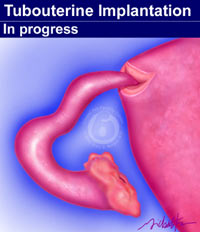Tubouterine Implantation: Best Procedure For Proximal tubal blockage
Implantation of the fallopian tube is inserting the tube through a new opening into the uterus. Tubouterine implantation is correct medical terminology, but it is also called tubal implantation, uterotubal implantation, or uterine implantation.
Most tubal ligation operations leave two fallopian tube segments that can be reconnected. In some cases, only one tubal segment remains that is separated from the uterus and the portion of the tube within the uterine muscle is blocked as well. This is most likely to occur when a tubal ligation has been performed by monopolar tubal coagulation applied to the tubal segment next to the uterus. In this situation, tubal implantation is required as the tubal reversal procedure.
In 2001 Essure sterilization was approved by the FDA for use in the United States. Essure causes blockage of the proximal fallopian tube. Reversing Essure involves removing the proximal portion of the fallopian tube containing the Essure device and performing tubouterine implantation to restore patency (remove blockage) of the fallopian tube.
Tubal Implantation At A Personal Choice
 Tubal implantation is performed by making an incision through the uterine muscle. The incision is carried down into the uterine cavity. The tubal segment that has been separated from the uterus is opened and passed down until its proximal end is inside the uterine cavity. Before implanting the tube in the uterus, a suture is placed through the open end that goes inside the uterus. This suture is used to anchor the fallopian tube within the uterine cavity.
Tubal implantation is performed by making an incision through the uterine muscle. The incision is carried down into the uterine cavity. The tubal segment that has been separated from the uterus is opened and passed down until its proximal end is inside the uterine cavity. Before implanting the tube in the uterus, a suture is placed through the open end that goes inside the uterus. This suture is used to anchor the fallopian tube within the uterine cavity.
When the tube has been anchored inside the uterine cavity, sutures are placed in the uterine muscle around the implanted tube. Care must be taken to close the uterine incision sufficiently to allow healing, but not so tightly that it compresses or constricts the implanted tube. Tubal implantation is a more difficult operation to perform than tubal anastomosis.
Historically, tubouterine implantation accounted for 1% of tubal reversal procedures at A Personal Choice.
As a result of Essure tubal occlusion becoming more popular, tubouterine implantation accounts for 25% of all procedures performed at a Personal Choice.









